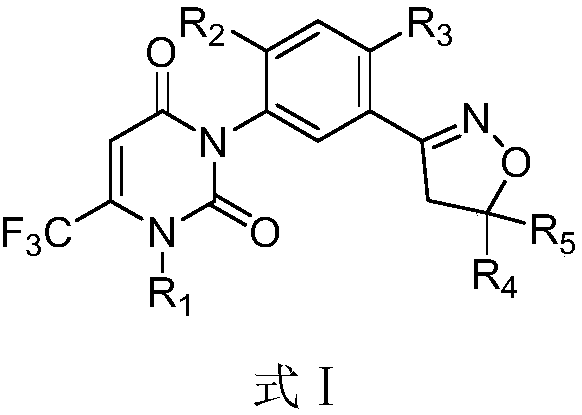Herbicide and application thereof
A technology of herbicides and solvents, applied in the field of herbicides of uracil compounds, capable of solving problems such as no compound A
- Summary
- Abstract
- Description
- Claims
- Application Information
AI Technical Summary
Problems solved by technology
Method used
Image
Examples
Embodiment 110
[0182] Embodiment 1 10% compound A emulsion in water
[0183] Add 10% compound A, 5% T-20, 3% EL-80, 1% 500#, 4% ethylene glycol, 15% caprylamide, 30% methyl oleate into the mixing tank, stir and mix to dissolve To form a uniform oil phase, under high-speed stirring, add the remaining amount of water (to make up to 100%) into the oil phase to obtain a 10% compound A water emulsion with good dispersibility.
[0184] Seal the obtained 10% water emulsion sample of Example 1 and the original drug with an ampoule bottle, and store it in a thermostat at 54±2°C for 14 days. The liquid chromatographic analysis method is used to analyze and detect the content changes of the active ingredients before and after storage. Its decomposition rate is less than 5%. The analysis results are shown in Table 1
[0185] Table 1
[0186]
[0187] The results show that in the preparation system, methyl oleate is added, so that the decomposition rate of Example 1 is significantly smaller than t...
Embodiment 2
[0188] Embodiment 2 10% compound A emulsion in water
[0189] Add 10% compound A, 2% 600#, 4% 1601, 2% 500#, 4% ethylene glycol, 20% caprylamide into the mixing kettle, stir and mix to dissolve into a uniform oil phase, under high-speed stirring, A 10% compound A water emulsion with good dispersibility can be obtained by adding the remaining amount of water (to make up to 100%) into the oil phase.
[0190] The 10% emulsion in water sample obtained in Example 2 and the original drug were sealed in ampoules, and stored in a thermostat at 54 ± 2°C for 14 days. The liquid chromatographic analysis method is used to analyze and detect the content changes of the active ingredients before and after storage. Its decomposition rate is greater than 5%. The analysis results are shown in Table 2
[0191] Table 2
[0192]
[0193] The result shows that the decomposition rate of embodiment 2 is greater than the original drug decomposition rate.
Embodiment 3
[0194] Example 3 10% Compound A Dispersible Oil Suspension Concentrate
[0195] Add 10% compound A, 5% O-3, 10% S-80, 5% T-80, 1% organic bentonite, and the remaining amount of methyl oleate (to make up to 100%) into the mixing kettle, and use high shear Stir and mix with a cutting machine, and then sand mill with a sand mill to obtain a 10% compound A dispersible oil suspension concentrate with good dispersibility.
[0196] Seal the obtained 10% dispersible oil suspension concentrate sample of Example 3 with the original medicine ampoule, and store it in a thermostat at 54±2° C. for 14 days. The liquid chromatographic analysis method is used to analyze and detect the content changes of the active ingredients before and after storage. Its decomposition rate is greater than 5%. The analysis results are shown in Table 3
[0197] table 3
[0198]
[0199] The result shows that the decomposition rate of embodiment 3 is less than the original drug decomposition rate.
PUM
 Login to View More
Login to View More Abstract
Description
Claims
Application Information
 Login to View More
Login to View More - R&D
- Intellectual Property
- Life Sciences
- Materials
- Tech Scout
- Unparalleled Data Quality
- Higher Quality Content
- 60% Fewer Hallucinations
Browse by: Latest US Patents, China's latest patents, Technical Efficacy Thesaurus, Application Domain, Technology Topic, Popular Technical Reports.
© 2025 PatSnap. All rights reserved.Legal|Privacy policy|Modern Slavery Act Transparency Statement|Sitemap|About US| Contact US: help@patsnap.com



